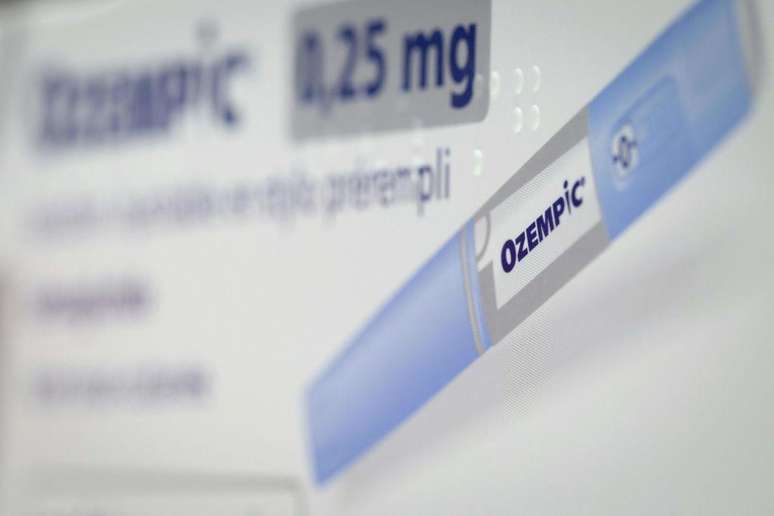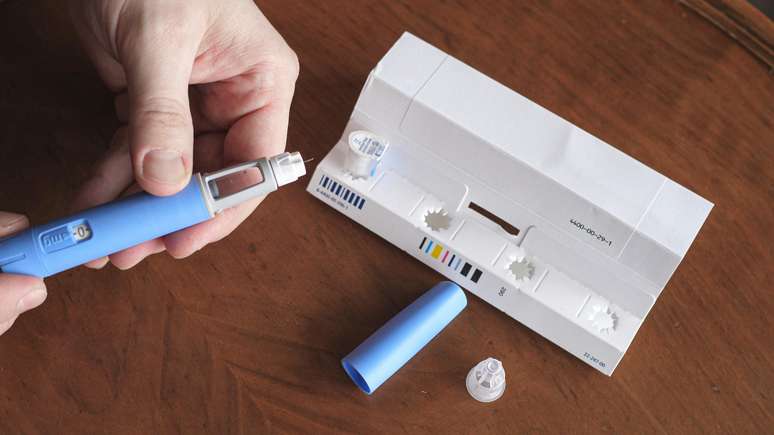Fernanda Guimarães Pimenta, 29, decided to use the drug without medical advice to lose weight.
html[data-range=”xlarge”] figure image img.img-b0713603d104326922594f7247d04e4ai5phghk3 { width: 774px; height: 435px; }HTML[data-range=”large”] figure image img.img-b0713603d104326922594f7247d04e4ai5phghk3 { width: 548px; height: 308px; }HTML[data-range=”small”] figure image img.img-b0713603d104326922594f7247d04e4ai5phghk3, html[data-range=”medium”] figure image img.img-b0713603d104326922594f7247d04e4ai5phghk3 { width: 564px; height: 317px; }
Just type “Ozempico” in social network searches to find videos showing people who claim to have lost weight using the drug and give their testimonials about it.
Was looking for this result that the publicist Fernanda Guimarães Pimenta, 29 years olddecided to do the use of drugs without medical advice AND ended up in intensive care and almost had one liver failure – when the liver stops working.
After seeing these videos on social media, Fernanda decided to use Ozempic, a “pen” with a needle on the end, without medical supervision in July last year. She also knew some friends who were using the drug and were losing weight quickly.
“I started being influenced by videos, I even joke that I was influenced by my own work as I am an advertiser. The algorithm started showing me different videos which were talking about using Ozempic and its positive results. So, I I made it into my head that if I took it, it would also work very well,” he relates.
At the time, the publicist was dissatisfied with her body after gaining 10 pounds during the pandemic period and going from a 40 to a 44 mannequin. Working in the home office, she stopped walking to the office where she works, to São Caetano do Sul, increasing their sedentary lifestyle and contributing to weight gain.
In a note to BBC News Brazil, the Novo Nordisk laboratory, maker of Ozempic, explained that the drug is indicated for the treatment of adults with insufficiently controlled type 2 diabetes, as an adjunct to diet and exercise.
The manufacturer also adds that the drug should be used and marketed only by prescription, contraindicated for pregnant women, nursing mothers and patients allergic to semaglutide.
Regarding the complications experienced by Fernanda after using the drug without a prescription, the manufacturer explained that the drug does not interfere with liver function.
“It can be used in patients with mild and moderate hepatic impairment. There is little experience in patients with severe hepatic impairment. But there is no increase in liver enzymes related to the use of the drug. However, an increase in pancreatic enzymes may occur transient way and patients with a previous history of pancreatitis should use the product with caution,” it said in a statement.
“Gastrointestinal disturbances, such as nausea, were the most frequently reported adverse events, most of which were transient, mild in intensity, and did not lead to treatment discontinuation. These events occurred at a similar frequency compared to other GLP-1 analogues already marketed in Brazil Premature discontinuation of treatment due to adverse events was less than 10% in all groups studied1-7. It should be noted that treatment should always be guided by the recommendations provided by the responsible physician and it must be based on an individual assessment of the patient’s needs,” he added.
“Anxiety and Headaches”
“I was very insistent that my boyfriend buy the medicine for me. And to try to please me, he bought it in a pharmacy, without a prescription or any kind of restriction and paid R $ 850. , I was very confident that it would work and I would lose weight,” the publicist details.
Soon after purchasing the drug, Fernanda once again turned to social media videos to learn how to apply the drug and decided she would use Ozempic once a week, increasing the dose with each application.
“I applied the first injection. I started to experience a lot of anxiety and headaches, but until then I was within the symptoms expected from the drug and foreseen in the leaflet. The following week, I decided to increase the dosage on my own, passing 0.25 mg to 0.5 mg, thinking it would improve results,” recalls the publicist.
After the second application, the symptoms became more intense and the publicist decided to seek medical help by going to the city emergency room. There have been eight trips to the hospital to treat the symptoms which have not ceased.
Embarrassed, the young woman did not tell doctors that she was using Ozempic without professional supervision.
“I couldn’t stop throwing up, I had a lot of pain in my stomach and spent the day feeling nauseous. I went to the ER eight times to get medication into a vein and nothing helped. I came home and kept throwing up,” he recalls. .
“I was embarrassed to tell the doctor I was using it myself, so I said I was taking Ozempic, but that a doctor had recommended it,” she adds.

After blood tests, doctors discovered that the publicist had changes in her liver and asked her to be hospitalized. Due to the seriousness of Fernanda’s health condition, she was referred to intensive care so doctors could closely monitor her liver enzymes, which, according to the publicist, were more than ten times higher than considered normal .
“I said I didn’t want to stay in the ICU and the doctor was very sincere and said ‘either I’ll put you in to monitor your liver, or you can queue up for the transplant’ because if the enzymes keep going up, my organ would stop.” to work,” the ad reads.
In addition to the liver problem, the publicist has also been diagnosed with gallstones. Experts don’t know if it was triggered by the use of Ozempic or if the young woman already had the problem and it was only enhanced by the drug.
There were seven days of being in the ICU, taking painkillers and checking his liver. With treatment, Fernanda’s liver enzymes decreased, indicating healing of the organ, ruling out the need for a transplant.
Once recovered, the publicist started bodybuilding twice a week and has already shed seven of the ten kilos she gained during the pandemic.
What is Ozempic and when is it named?
Ozempic is the brand name for an injectable drug called Semaglutide, which was originally shown to help treat type 2 diabetes.
Semaglutide helps control blood sugar by increasing the production of insulin and reducing the production of glucose by the liver. Being a medicine, the dose and the way to use it should be guided by a doctor.
“It helps control blood sugar, reduces cravings, and slows gastric emptying, which means food stays in the stomach longer, providing a feeling of fullness. Plus, it may reduce body fat. In studies, clinical trials Semaglutide has been shown to improve insulin sensitivity and increase fat burning, which can help with weight loss, diet and exercise habits,” explains Carla Adriana Loureiro de Matos, a hepatologist at the hospital’s advanced medicine center Sirio Libanes.

Despite this, unlike what happens in Europe and the United States, Semaglutide is not yet released by Anvisa (National Health Surveillance Agency) for use exclusively against obesity in Brazil.
“Its use is recommended for adults with type 2 diabetes, as an aid in treatment, along with diet and exercise. It can be used as a single drug, but can also be used in combination with other drugs, if needed. Ozempic is not yet released for use in children and adolescents under 18 and should not be used in pregnant women due to a lack of studies with this audience,” adds Matos.
As with any drug, its indiscriminate use can have serious consequences, such as:
– Potentiation of diabetic eye complications;
– Severe dehydration with renal insufficiency;
– Severe acute pancreatitis.
“Patients using Ozempic, if they are going to have a surgical procedure, for example, should stop using it several days in advance or their fast, which for surgery would be 8 hours, should be 48 hours, because patients they can aspirate the stomach contents at the time of intubation,” explains Rodrigo Surjan, surgeon at Nove de Julho hospital.
Why does it lose weight so fast?
One of the “side effects” of Semaglutide is rapid weight loss. This is because Semaglutide, which is an agonist (mimicking the action) of a hormone called GLP-1, is produced in the intestine and, in addition to helping with glycemic control, also acts in the hypothalamus, reducing the desire to eat. And, as already demonstrated in some studies, it also improves emotional hunger, i.e. eating out of anxiety.
“Studies targeting the treatment of obesity with Ozempic have been conducted and it has been observed that higher doses would have a better effect on weight loss. With this study, a drug under the trade name of Wegovy was approved in Brazil, which is not yet been marketed in pharmacies, but it will arrive soon. It has a higher dose of Semaglutide than you have in Ozempic, being more effective in the treatment of obesity, “explains Fábio Trujilho, director of the Obesity Department of the Brazilian Society of Endocrinology and Metabolism ( SBE).
Wegovy, the specific drug against obesity, also has Semaglutide as its active ingredient. It has already been approved by Anvisa and contains 2.4 mg (Ozempic has 1 mg).
“This drug can result in an average loss of 17% of body weight and can be safely used in people with or without diabetes. It greatly reduces the possibility of side effects,” says Bruno Geloneze, Unicamp researcher and scientific department member at Abeso ( Brazilian Association for the Study of Obesity and Metabolic Syndrome).
However, approval does not mean that it can be used indiscriminately and by anyone who wants to lose weight.
One of the criteria for indicating drugs in the treatment of obesity is a body mass index (BMI) greater than 30 (BMI < 30 = grade 1 obesity), or in persons who have a BMI greater than or equal to 27 and who have other comorbidities associated with obesity and weight loss may contribute to the overall improvement.
To calculate BMI, simply divide a person’s weight by their height squared. The number obtained from this mathematical operation falls into one of the following categories:
Less than 18.5 – underweight
Between 18.5 and 24.9 – normal weight
Between 25 and 29.9 – overweight
Between 30 and 34.9 – grade 1 obesity
Between 35 and 39.9 – grade 2 obesity
Over 40 – grade 3 obesity
“It happens that we see many people resorting to self-medication without following these criteria. Sometimes people of normal weight, who want to lose 2 or 3 kg and end up using the medicine improperly, since it does not have this indication”, says the director of SBEM.
Source: Terra
Ben Stock is a lifestyle journalist and author at Gossipify. He writes about topics such as health, wellness, travel, food and home decor. He provides practical advice and inspiration to improve well-being, keeps readers up to date with latest lifestyle news and trends, known for his engaging writing style, in-depth analysis and unique perspectives.









